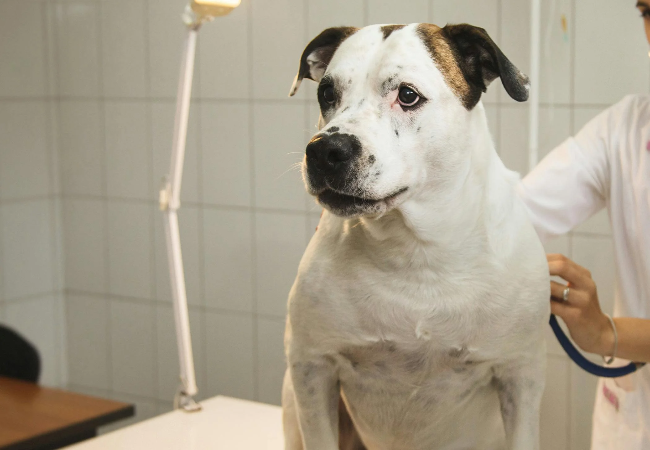Peritoneopericardial Diaphragmatic Hernia Vet Guide 2025 🩺🐶

In this article
Peritoneopericardial Diaphragmatic Hernia Vet Guide 2025 🩺🐶
By Dr. Duncan Houston BVSc
📚 What Is Peritoneopericardial Diaphragmatic Hernia (PPDH)?
Peritoneopericardial diaphragmatic hernia (PPDH) is a congenital defect where a hole persists between the abdominal cavity and the pericardial sac around the heart. This allows abdominal organs—like the liver, stomach, and intestines—to migrate into the pericardial space. Unlike traumatic diaphragmatic hernias, PPDH is present at birth and develops during fetal formation of the transverse septum. It is the most common congenital pericardial anomaly seen in dogs and cats.
🧬 Breed Predisposition & Genetic Origins
While PPDH can occur in any breed, certain breeds show a higher incidence:
- Weimaraners are notably over‑represented.
- Cocker Spaniels also have an increased risk.
- Clinically, it may also occur in mixed‑breed dogs.
The root cause is embryologic misdevelopment, not trauma. It results from the failure of proper separation between the pericardial and abdominal compartments during gestation.
🔍 Common Signs & Clinical Presentation
Many dogs with PPDH are asymptomatic, and the condition is often found incidentally during imaging for other reasons. When present, signs may include:
- Respiratory issues: coughing, difficulty breathing.
- Gastrointestinal problems: vomiting, diarrhea, poor appetite, weight loss.
- Cardiac murmurs or muffled heart sounds: due to fluid or organ compression.
- Subclinical findings: abdominal emptiness, normal bloodwork.
The severity correlates with how much abdominal content enters the pericardial sac.
🩺 Diagnostic Approach
Diagnosing PPDH requires careful physical exam and multi-modal imaging:
- History & physical: watch for respiratory or GI concerns; heart and lung sounds may be abnormal.
- Thoracic radiographs show the absence of diaphragm silhouette and the presence of abdominal organs in the chest area.
- Contrast peritoneography: flooding the abdominal cavity with contrast improves imaging accuracy.
- Ultrasound/echocardiography: may visualize the liver, gallbladder, in pericardium.
- Advanced imaging (CT/MRI): ideal for surgical planning.
- Lab tests: CBC/chemistry are usually unremarkable unless major organ compromise.
⚖️ Treatment: Surgery vs Conservative Management
Surgical Intervention
Definitive correction involves herniorrhaphy—repositioning organs and suturing the diaphragm defect via ventral midline or paramedian incision.
Outcomes:
- Operative mortality rates are low (~8–10%).
- Clinical signs resolve in ~85% of animals post-op.
- Recurrence is rare, with low complication rates.
- New techniques, like ventral diaphragmatic advancement, report good success.
Conservative Management
In asymptomatic adult dogs with incidental PPDH, monitoring may be reasonable. Long-term outlook is encouraging in both surgery and conservative cases—surgically treated dogs median survival of ~8.2 years, non‑surgical ~5 years.
🛡️ Stabilization & Emergency Care
In symptomatic or emergency:
- Provide respiratory support (oxygen).
- Stabilize and decompress the stomach/organs if causing distress.
- Plan surgery once the vitals are stable.
Post-op, monitor for re-expansion pulmonary edema.
📋 Prognosis & Long-Term Care
Favorable outcome with timely intervention:
- Surgery: ~90% short-term survival; the majority resolve symptoms.
- Conservative: Asymptomatic patients can live many years without issues.
- Prognosis depends on severity, adhesions, and concurrent congenital defects.
- Late repair can be complicated by abdominal organ adhesions.
🏡 At‑Home Management & Owner Guidelines
- Monitor respiratory signs, appetite, and weight.
- Schedule regular imaging to detect changes.
- Manage activity—avoid heavy exercise during recovery.
- Provide a calm, stress-free environment.
- Ensure prompt veterinary attention for new symptoms.
- Consider pet insurance to offset surgical costs ($2,500–$10,000 depending on complexity).
🌟 Ask A Vet Support Integration
For tailored care:
- Use Ask A Vet telehealth for follow-up and symptom monitoring post-surgery.
🎓 Case Example & Clinical Insight
A recent canine PPDH case underwent ventral diaphragmatic advancement repair with no complications, full recovery by discharge, underscoring modern surgical success.
📌 Summary & Takeaways
- PPDH is a congenital, not traumatic, defect frequently asymptomatic.
- Diagnostic imaging is key—radiographs, ultrasound, CT.
- Surgical repair offers high success; conservative care is acceptable for mild cases.
- Prognosis is generally positive with proper intervention.
- Ongoing home monitoring and Ask A Vet support improve long-term outcomes.
Dr Duncan Houston BVSc, Ask A Vet founder. Don’t forget to download the Ask A Vet app for instant expert support anytime. Your pet deserves paw-fect care! 🐾






